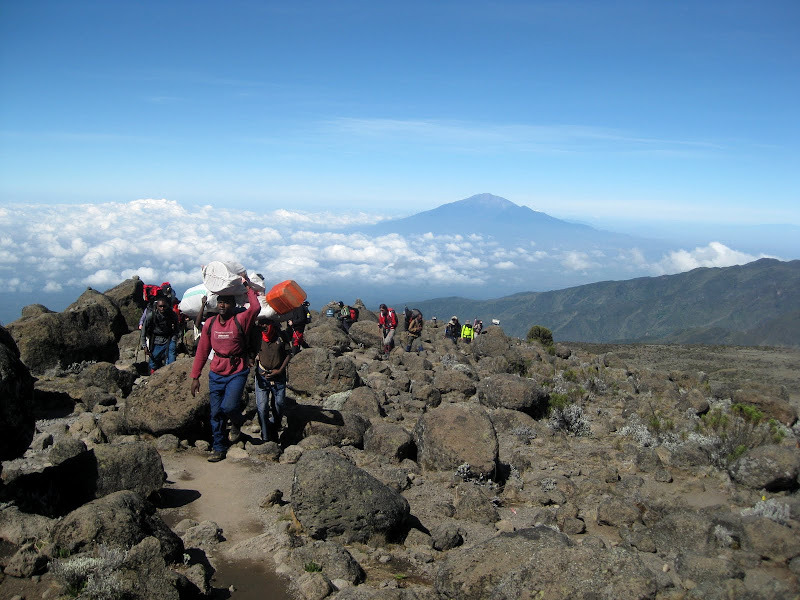 There are thousands of porters that work on Mt. Kilimanjaro, and many of them work in less-than-ideal conditions. While in the region, we had the opportunity to meet with Karen Valenti, a woman doing amazing work to help improve porter conditions on Kili. I wrote a World Nomads blog post on the subject, which can be found here, or copied below.
There are thousands of porters that work on Mt. Kilimanjaro, and many of them work in less-than-ideal conditions. While in the region, we had the opportunity to meet with Karen Valenti, a woman doing amazing work to help improve porter conditions on Kili. I wrote a World Nomads blog post on the subject, which can be found here, or copied below.
Kilimanjaro Porters – Helping Them Help You Up The Mountain
I’ve never had anybody carry my stuff for me before.
At least, not on a trekking trip. And to be honest, I was a little bit uncomfortable about it. See, I consider myself a fairly avid backcountry hiker, spending many weekends each summer in the Colorado wilderness. The thought of hiring someone to carry my food, tent, clothes, sleeping bag, etc, just seems like cheating. So, when my wife and I arrived at the Machame trailhead of Mt Kilimanjaro, I was appalled to find 12 people there to assist us up the mountain! As it turns out, there is no way we would have made it up Kili without them (at least, not in 5 days), and I have come to highly respect Kilimanjaro porters and the often dire working conditions they face every time they set foot on the mountain.

Kili porters working too hard
“My team, they are not just porters, they are mountaineers,” boasts my guide, Goodluck (yes, that is his real name). And he’s right – these guys are heaving heavy, awkward-shaped, poorly packaged gear up some of the most challenging non-technical trekking routes on the planet. And, they are doing it in almost any weather condition, often with very poor equipment (I saw more remnants of old shoes and boots on the trail than I care to remember). These guys have to be tough, but too often on Kili, they are working harder than they should be.
Why are things so rough for porters?
They are the low link on the Kilimanjaro food chain, there is lots of competition for work (over 15,000 porters work on the mountain!), and their low level of education and training has kept them from having a voice. Here are a few of their most common challenges:
- Climbing companies sometimes fail to pay their porters on time, sufficiently, or at all
- Some porters are not provided with appropriate mountain gear, from clothing to footwear to tents
- Some porters are given insufficient food – as little as 1 meal per day
- Some porters are made to carry well over the maximum weight of 25kg (a regulation set by the park, but often ignored by the climbing companies)
- Some guides (often former porters themselves) require a bribe to be chosen to work
- Some guides fail to distribute guest tips fairly, keeping more than their own share
Fortunately, the situation is improving significantly, thanks largely to the work of Karen Valenti and the Kilimanjaro Porters Assistance Program (KPAP), a Tanzanian NGO. Created by the International Mountain Explorers Connection in 2003, KPAP has been fighting for porters rights and welfare through grassroots activism, education, research, and monitoring. The organization works directly with porters to provide complimentary gear rental, while also working with the climbing companies to ensure they are following ethical guidelines for porter treatment established by KPAP. Karen, KPAP’s director, is a passionate individual who spends most of her time at Kili trailheads interviewing and surveying porters and climbers to ensure standards are being met. Climbing companies who have demonstrated their adherence to KPAP standards are granted “partner” status – a label that has become a must-have for any responsible travel providers running trips to Kili.

Kili porters
Interested in climbing Kilimanjaro?
Your travel choices have the power to make a positive impact. Here’s what you can do to ensure your porters are treated fairly:
- If your favorite tour operator is not on the list (and they run trips to Kilimanjaro), call them up and ask them why they have not joined, and when they plan to
- Be sure to tip well (plan it into your trip budget), and be sure to tip directly to the porters

 There are thousands of porters that work on Mt. Kilimanjaro, and many of them work in less-than-ideal conditions. While in the region, we had the opportunity to meet with Karen Valenti, a woman doing amazing work to help improve porter conditions on Kili. I wrote a World Nomads blog post on the subject, which can be found
There are thousands of porters that work on Mt. Kilimanjaro, and many of them work in less-than-ideal conditions. While in the region, we had the opportunity to meet with Karen Valenti, a woman doing amazing work to help improve porter conditions on Kili. I wrote a World Nomads blog post on the subject, which can be found